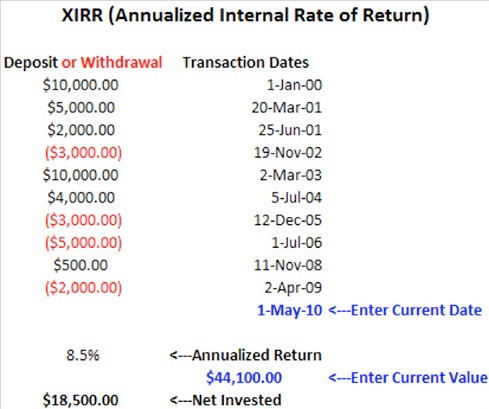Personal Rates of Return Money Weighted v Weighted
Post on: 14 Июнь, 2015 No Comment

There was a good question in my last retirement portfolio update about how my personal rate of return was 41% YTD, which was actually higher than any individual mutual fund in my portfolio*. The reason for this is mainly due to terminology, which can be especially confusing since the definitions seem to have shifted with time.
Geometric mean return
Time-Weighted Return Details
This methodology does not account for any cash inflows or outflows. In a way, finding your return using this method assumes that you dont make any transactions at all. For a year-to-date calculation, its the same as asking how $100 invested on January 1st would end up today.
My favorite term for this method is Investment Return, because it essentially tracks the performance of your investments. and nothing else. If you have 30% US Stocks, 30% International Stocks, 30% Bonds, and 10% Orange Juice Futures, such a set of investments will have a unique performance from January 1st until today. Along the same lines, this time-weighted performance is what you get when looking up the total returns of a specific mutual fund (example ). This also makes it easy to compare to a benchmark, such as the S&P 500 Index.
Money-Weighted Return Details
This methodology does account the size and timing of any cash inflows or outflows into your portfolio. Heres an example of the difference. In your brokerage statements, look for any reference to accounting for deposits and withdrawals. Below is a chart of the S&P 500 index for all of 2009. Lets say you started with $10,000 invested in the S&P 500 on January 1st. Then in early April before the tax deadline, you hurry and purchase $5,000 more worth.
As you might imagine, your $5,000 inflow was some good timing, and the performance of that money is a lot better (+25%) than the performance of your $10,000 from January 1st (+17%). If you managed to get your money in around March 9th, the return of that money year-to-date would be over 50%.
I prefer to call this methodology the Personal Rate of Return because it is truly personal. It is unlikely that any people have the exact same transaction amounts and dates as you. However, while this number may seem more accurate, its harder to compare against a benchmark and use for future investment decisions. As seen above, luck in the timing of your investments can swing the numbers either way.
I have an older post on how to calculate this dollar-weighted rate of return. but the Zohosheets arent displaying ideally right now. You can click on Full Screen View or try this page instead if you have Excel and the XIRR function installed.
What method do major investment firms use?
When Fidelity first started including personal rate of return in peoples 401(k) statements, it was a time-weighted rate of return. According to this 2000 LA Times article. Fidelity thought it was more appropriate to allow comparisons to published mutual fund numbers. At that same time, a spokesperson from Vanguard thought investors would be too confused either way, so they published nothing:
We have several reservations about such reporting, says Vanguard Group spokesman John Woerth. Among them: Personal returns and fund returns are likely to differ, and perhaps substantially, which could confuseeven misleadinvestors.
How about today? When I checked my statements, both Fidelity and Vanguard use the money-weighted method for their personal rate of return. Our other 401(k) provider did as well, so it seems like things are shifting. I guess Vanguard thinks were smart enough to see the number now. In the end, as long as you understand the differences, I think both stats can be useful.
* This is mostly true, but actually my small allocation to an Emerging Markets fund (VEIEX ) is up 60% YTD.














